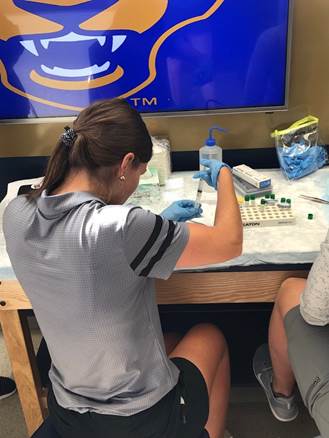From the grocery store to the bright lights: A look inside Pitt’s efforts in sports nutrition

Photo courtesy of Pitt Athletics
Sweat testing the men’s soccer team with Gatorade Sports Science Institute.
September 22, 2020
When top-tier athletes take the field, they aim to cash in on years worth of preparation on and off the field. While talent, of course, plays a large role in the success of all players, commitment and preparation are what separate the good from the great.
Successes often come as a result of perpetual exercise and nutrition routines — take Tampa Bay Buccaneers 43-year-old quarterback Tom Brady or recent U.S. Open champion Bryson DeChambeau as examples — along with years of discipline and habit. The “sports science” behind many modern training methods is relatively new, but the results are impossible to deny. A look around the sports landscape — Los Angeles Lakers forward Lebron James comes to mind — reveals that athletes who commit to preserving their bodies and emphasize overall health rather than only sport-specific training are bound to maintain a higher level of play for longer than their counterparts.
Collegiate athletic programs are looking to do everything they can to ensure the overall health of their players as well, and Pitt Athletics, led by nutrition director Auburn Weisensale, is no different. Sports nutrition is her primary focus.
“If you’re going to be elite in your sport,” Weisensale said, “then you need to be elite in nutrition.”
Weisensale, who assumed her role with Pitt Athletics in 2016, heads a high-scale operation throughout numerous athletic programs. Her work spans from educating athletes on nutrition through grocery tours to performing nutritional cooking demonstrations to being on-hand during Pitt game days and practices.
Adaptability is one of the most important traits required of a college sports nutritionist. Nothing could have tapped into this more than the COVID-19 pandemic, and Pitt’s staff was ready for the challenge.
Similar to scenes in Pitt’s isolation housing, the sports nutrition team has spent the beginning of the fall semester planning and preparing days’ worth of meals in advance and delivering them to the athletes in a non-contact manner.
“[Our precautions include] doing pre-portioned meals, no self-serve buffet-style meals, limiting the time and number of people with access to the nutrition stations, making individual fuel bags for athletes to limit visits at the fueling stations, increased frequency of regular cleaning and sanitizing protocols, [and more],” Weisensale said.
Weisensale and her staff work closely with Pitt’s coaches to ensure the athletes fuel themselves correctly to maximize their performance — even coordinating with hotel staff to craft beneficial menus when the Panthers travel.
“We do a large variety of things,” Weisensale said. “As dieticians, we look to help guide [the athletes] with their eating habits, their routines and with how to balance that out with their classes.”
She emphasized that their entire process revolves around maximizing athlete growth. While Pitt’s nutrition team aims to provide athletes with consistency and routine, nutritionists rely on their ability to adapt and form drastically different plans for different players.
“You never know what you’re going to get,” Pitt Sports Nutrition Fellow Emma Gorski said. “Not only are we helping these athletes navigate through their busy schedules, but we get to watch them reap the rewards of their hard work firsthand. It’s really exciting.”
Recommendations for different athletes can vary in all forms. A wrestler who needs to lose weight in a matter of days to qualify for their match, for example, requires a far different plan than a swimmer who needs to eat eight times a day to account for their rigorous calorie burning.
Varying levels of weight and energy usage lead to enormously different custom plans for each athlete.
Even within the same sport, Sina D’Amico, a sports nutrition fellow, said plans can vary. She cited cross-country as an example, noting that a seemingly small difference such as being a sprinter versus being a long-distance competitor can lead to an entirely differently shaped nutrition plan.
Weisensale said dieticians shape the players’ routines based on time of year and proximity to their seasons.
“We focus on a lot of education and behavior change [during the] offseason so that by the time [the athletes] get to the season, they’ve already reached their goals and are where they need to be for competition,” Weisensale said.
Even if all is going well for an athlete, an injury can derail everything. A player sidelined by an injury can be a major curveball for their objectives in nutrition — and like everything in their off-the-field routine, such an occurrence requires extensive planning. The nutrition staff is doing just that, creating detailed adjustments in preparation for accidents.
“We are in the middle of developing an injury protocol,” Gorski said. “Once an athlete is injured, we’ll be notified immediately, and from there we can work with them closely to provide them with a nutrition plan to help them heal and avoid muscle loss.”
Having these kinds of support systems is what Pitt hopes will help build its programs in the modern era of sports training. Preparation is key, and measures taken by teams such as the Panthers’ sports nutrition staff ensure that athletes will have a plan no matter what comes their way.


